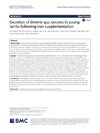Identificador persistente para citar o vincular este elemento:
https://accedacris.ulpgc.es/jspui/handle/10553/42256
| Título: | Excretion of Eimeria spp. oocysts in young lambs following iron supplementation | Autores/as: | Odden, Ane Vatn, Synnove Ruiz Reyes, Antonio Robertson, Lucy Jane Enemark, Heidi Larsen Nes, Silje Katrine Tommerberg, Vibeke Stuen, Snorre |
Clasificación UNESCO: | 310907 Patología | Palabras clave: | Coccidiosis Eimeria spp. Iron supplementation Norway Sheep |
Fecha de publicación: | 2018 | Editor/a: | 0044-605X | Publicación seriada: | Acta Veterinaria Scandinavica | Resumen: | Background Iron is an essential nutrient, and iron supplementation has been shown to reduce the incidence of abomasal bloat in lambs. Additionally, iron deficiency is linked to pica, which may increase uptake of Eimeria oocysts. Coccidiosis in sheep, caused by Eimeria spp., is an important infection, leading to reduced welfare and economic losses. The aims of our study were to investigate: (1) the use of iron supplementation in Norwegian sheep flocks using a questionnaire survey, and (2) whether iron supplementation reduced excretion of Eimeria oocysts and increased the growth rates of young lambs. Results A questionnaire regarding the use of iron supplementation, sent to all members of the Norwegian Sheep Recording System (n = 4993), showed that 152/1823 farmers iron-supplemented lambs, either orally (56.7%) or by injection (43.3%). The main purpose of supplementation was to prevent abomasal bloat (38.4%), coccidiosis (9.3%), or both (27.8%). In the field study, 102 twin lambs from five flocks were included: one twin (treated) received 600 mg of gleptoferron subcutaneously within 3 days of birth, whereas the control was given saline. McMaster analysis of individual faecal samples obtained at weekly intervals (n = 4 per lamb, starting at turnout) showed no significant difference in oocyst excretion between treatment groups at any sampling, except for one flock 14 days after turnout. Mean growth rates, measured at iron injection, 21 days after turnout, and in the autumn, differed significantly between treated and untreated lambs from iron injection to 21 days after turnout, however, no difference in growth rates was observed in the overall period from iron injection to autumn. Blood analysis suggested that the controls were at risk of developing iron deficiency anaemia during the housed period, but signs of anaemia were not observed. Conclusion Iron supplementation of lambs was used by 8.3% of the farmers responding to the questionnaire, mainly with the intention to prevent abomasal bloat, coccidiosis, or both. The field trial results indicate that iron supplementation of young lambs do not reduce oocyst excretion and only induced a transitory increase in weight gain. However further studies, including more flocks and possibly repeated iron injections, would provide more definitive information. | URI: | https://accedacris.ulpgc.es/handle/10553/42256 | ISSN: | 0044-605X | DOI: | 10.1186/s13028-018-0404-6 | Fuente: | Acta Veterinaria Scandinavica [ISSN 0044-605X], v. 60 |
| Colección: | Artículos |
Citas SCOPUSTM
4
actualizado el 08-jun-2025
Citas de WEB OF SCIENCETM
Citations
4
actualizado el 08-jun-2025
Visitas
120
actualizado el 27-jul-2024
Descargas
131
actualizado el 27-jul-2024
Google ScholarTM
Verifica
Altmetric
Comparte
Exporta metadatos
Los elementos en ULPGC accedaCRIS están protegidos por derechos de autor con todos los derechos reservados, a menos que se indique lo contrario.
